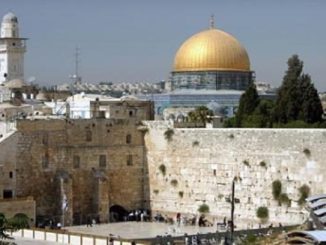
By Rima Najjar
When people refer to the Palestinian-Israeli conflict, they sometimes refer to it as an arena, not only of a geopolitical struggle between Zionist Jewish colonizers initially from Eastern Europe, on the one hand, and the indigenous Palestinian Arabs, on the other, but also as a struggle between two religions over “ownership” of holy places in Palestine.
People who define the conflict in the religious terms take Christianity out of the equation in such a discussion and also may lack an understanding of how holy places in Jerusalem and elsewhere have been administered historically.
A body of assumptions and misconceptions have grown around the Palestinian struggle for justice that are rarely debated or questioned under pain of bigotry, as has happened in France, where a law now equates anti-Zionism with anti-Semitism.
These misconceptions have to do with the notion that Palestinian Arabs have no real grievance against Israel and therefore no rational basis for their hostility toward Israel. And since the vast majority of Palestinian Arabs are Muslim, and as Israel claims Palestine as the “Land of Israel”, a state exclusively for Jews worldwide, with sovereignty today over all of historic Palestine “from the river to the sea”, the misconception arises that the Holy Land of Palestine is holy to Jews alone.
It should be obvious to anybody with the slightest knowledge of the history of the region that Palestine is “holy land” to all three Abrahamic religions. Jerusalem has always been the focal point of Judaism. The mantra of “next year in Jerusalem” is a spiritual (not geopolitical) emblem central to the religious history of Judaism. Christian biblical history also locates holiness in the land of Palestine, a land in which Western Christians find special significance.
In the West, these two traditions, however, have represented Palestine’s Arabs and Muslims as aliens in their own land for not being biblical, not Christian or Jewish, and so “alien” to Palestine’s “true” Christian and Judaic heritage. Historians ignored Muslim history, skipping over to the Crusades and ignoring a thousand years of Arab Muslim history.
But the fact is, as Dr. Sari Nusseibeh says,
“Jerusalem is as holy to 2.2 billion Christians and 1.6 billion Muslims, as it is to 15–20 million Jews worldwide.”
Today in the Palestine/Israel conflict, Israel jumps in its rhetoric from ancient times to the 20th century, ignoring Palestine’s Muslim influence, which began under Caliph Omar in the 630s and stretched for 1400 years, with the interruption of the Crusaders’ influence in Jerusalem (1099–1291).
And so, whereas people understand that Christianity is a “continuation” of the tradition of the Old Testament, they do not understand or accept that Muslims believe their religion builds on both of these two traditions. For example, Islam recognizes in Qur’an, 5:21 the importance of the land of Israel in the religion of Judaism.
Seth J. Frantzman and Doron Bar map some of Islam’s holy sites in Palestine as follows:
“The Muslim tombs of local saints and prophets were an integral part of the landscape of British Mandate Palestine. They were ubiquitous and significant; located in almost all parts of the region, from the slopes of the Hermon Mountain in the north, to the Negev Desert in the south. These shrines were found in cities, towns and countryside, extending from the shores of the Mediterranean to the Great Rift Valley. However, no systematic study of their extent or significant analysis of the monuments has been undertaken. Using British period maps and additional sources from the 1930–40s, this study analyses almost 800 Muslim tombs and sanctuaries. Through comparison with the Palestine Exploration Fund survey of the 1870s and other sources from the Late Ottoman Period, the article identifies patterns associated with these tombs, including their history and, in some cases, their origins and the changes that they underwent during this period. Case studies of different regions and analysis of the physical and geographical location of the monuments also shed light on their significance in various regions of Palestine and to different population groups.”
Palestine was documented and described as a geographic region between the Mediterranean Sea and the Jordan River 3200 years ago — in the Bronze Age. The identity and history of the Palestinian people emerged long before the advent of Zionist settler-colonialism.
Palestine, the “Holy Land”, belongs to the people of Palestine of any religion in the geopolitical sense, and then, only spiritually, to the rest of the world. It does not belong as a Jewish state for Jews worldwide, as Zionism claims.
Here is a little historical context to explain the status quo of holy sites in Jerusalem, touted by Israel’s regime as its “eternal capital”:
When Israel occupied Arab Jerusalem in June 1967, it certainly wasn’t shy about changing the status of the city by illegally annexing it, passing three resolutions designed to judaize the sovereignty (June 27), the administration (June 28), and the Palestinian Arab Municipality in the form of dissolving the Municipal Council that had been elected by the residents of the city (June 29).
Still, the ‘Temple Mount’ debacle so often in the news today, wasn’t even on the radar then.
Under the harsh measures that Israel took upon illegally annexing Jerusalem, Palestinian Arab residents of Jerusalem appealed to international organizations, both Muslim and Christian, hoping to put an end to Israel’s expropriation of their land and to eliminate injustice.
In flagrant violation of international law, the Vatican signed an agreement with Israel (1993) over the objections of Palestinian Arab residents of the holy city (Christian and Muslim) in order to safeguard the financial and legal status of the Catholic State and its properties in Jerusalem. Israel, however, was reluctant to make similar agreements with institutions other than the Vatican, and so the endowments of the Orthodox Patriarchate were targeted and led to investment deals between Jewish organizations and the Greek bishops who controlled the Patriarchate. Again, this happened despite the strong opposition of the Orthodox Palestinian Arab followers of the church.
Jordan, which relinquished jurisdiction over the West Bank to the Palestinian side (the PLO), including responsibility for Jerusalem’s holy places — waqfs or endowments of holy sites — still maintains “guardianship” over waqf. (Also this is part of the 1994 Agreement between it and Israel.)
Jordan has tried to intervene against the changes Israel has forced in the status of holy places, and the ones now occurring regarding the Temple Mount issue, but to no avail.
It is important to understand in this context that Muslims, as Firas AlKhateeb points out, regard the Temple Mount site in Haram al-Sharif (the compound that houses the Al-Aqsa Mosque) as one of the foundations of their own tradition.
“For Muslims, Islam was not a new religion in the 600s when Prophet Muhammad ﷺ began preaching in Makkah. Instead, it is seen as a continuation and capstone of the traditions of earlier prophets that are revered by all three monotheistic faiths. The message of Muhammaﷺ only continues and perfects the messages of Ibrahim (Abraham), Musa (Moses), and ‘Isa, which had been corrupted over time. Thus, for Muslims, the Temple of Solomon that was built [on] Jerusalem’s Temple Mount in ancient times was in fact part of their own religious history.”
What ignited the interest in Haram al-Sharif (renamed ‘Temple Mount’) after 1967 is the strange alliance between fundamentalist Jews and evangelist Christians:
The Temple Mount business wasn’t even on the agenda in 1967. It started coming into prominence in Israeli politics with the preaching of Yehuda Joshua Glick, an American-born Israeli Orthodox rabbi and current member of the Likud party in the Israeli parliament.
Israel’s ongoing Judaization efforts and attempts to change the status of holy places in Jerusalem, Hebron and elsewhere are part and parcel of its Jewish supremacist agenda leading to the crime of apartheid as detailed by the UN report that acknowledges the reality of Israeli apartheid.
– Rima Najjar is a former professor (now retired) at Al-Quds University, Palestine. She comes from Lifta, Jerusalem and Ijzim, Haifa and currently lives in the United States. She contributed this article to the Palestine Chronicle.








“What ignited the interest in Haram al-Sharif (renamed ‘Temple Mount’) after 1967”
Not exactly:
“Although the term “Temple Mount” was first used in the Book of Micah (4:1) – literally as “Mount of the House” – it was not used again until approximately one thousand years later.[17][18] The term was not used in the New Testament.[19] The term was used next in the Talmud’s Tractate Middot (1:1–3, 2:1–2), in which the area was described in detail.[20] The term was used frequently in Talmudic texts thereafter.[21]